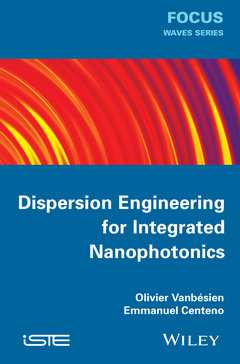Dispersion Engineering for Integrated Nanophotonics
Auteurs : Vanbésien Olivier, Centeno Emmanuel

This book shows how dispersion engineering in two dimensional dielectric photonic crystals can provide new effects for the precise control of light propagation for integrated nanophotonics.
Dispersion engineering in regular and graded photonic crystals to promote anomalous refraction effects is studied from the concepts to experimental demonstration via nanofabrication considerations. Self collimation, ultra and negative refraction, second harmonic generation, mirage and invisibility effects which lead to an unprecedented control of light propagation at the (sub-)wavelength scale for the field of integrated nanophotonics are detailed and commented upon.
INTRODUCTION vii
CHAPTER 1. Two-Dimensional Dielectric Photonic Crystals 1
1.1. Context 1
1.2. Concepts: photonic band structures and equi-frequency curves 2
1.2.1. Basic concepts on electromagnetic waves in 2D PhCs 3
1.2.2. Dispersion surfaces, equi-frequency curves and group velocity 6
1.3. Fundamental dispersion effects 8
1.3.1. The construction line method 8
1.3.2. A beam propagation model 9
1.3.3. The self-collimation effect 12
1.3.4. Mesoscopic self-collimation of light 14
1.3.5. The superprism effect 18
1.3.6. Negative refraction and -1 effective index in photonic crystals and metamaterials 20
1.4. From concepts to reality 26
1.4.1. 2D½ prototype design 27
1.4.2. Thick substrate versus membrane approach 27
1.4.3. 2D patterning and prototype designs 29
1.4.4. The 3D reality 34
1.5. Conclusion 35
CHAPTER 2. Flat Lenses 37
2.1. Context 37
2.2. Negative refraction based flat lenses 38
2.2.1. Effective parameters 38
2.2.2. A 2D photonic crystal based flat lens: dimensioning 42
2.2.3. Experiments 51
2.3. Gradient index lenses 56
2.3.1. GRIN lens concept 56
2.3.2. Negative index based GRIN lens (the hole case) 57
2.3.3. Positive index based GRIN lens (the pillar case) 59
2.3.4. Experimental evaluation of GRIN lenses 60
2.4. Conclusion 62
CHAPTER 3. Towards Transform Optics Based Devices 63
3.1. Context 63
3.2. From transform Optics to Hamiltonian optics 64
3.2.1. Transform Optics 64
3.2.2. Conformal mapping 69
3.2.3. Hamiltonian optics 70
3.3. 1D graded photonic crystals 72
3.3.1. D graded photonic crystals 75
3.4. Cloaking devices 78
3.4.1. A brief overview of optical cloaking 79
3.4.2. A III-V based photonic crystal carpet: design and fabrication 81
3.4.3. A III-V based photonic crystal carpet: evaluation and discussion 83
3.5. Conclusion 85
CONCLUSION 87
BIBLIOGRAPHY 91
INDEX 105
Olivier Vanbésien is Professor at the University of Lille and a researcher at IEMN (Institute of Electronics, Micro-electronics and Nanotechnology) in Villeneuve d'Ascq, France. He is the author of Artificial Materials, published in 2012, has authored and co-authored 70 papers in international journals and has presented 40 papers at international conferences. His current research field concerns the development of photonic crystal or metamaterial-based flat lenses for operation at 1.55m.
Emmanuel Centeno is Professor at Blaise Pascal University in Clermont-Ferrand, France. His research fields cover electromagnetic theory and simulations of photonic crystals and metamaterials. He has recently developed new concepts of graded photonic crystals and second harmonic metamaterial flat lenses.
Date de parution : 03-2014
Ouvrage de 128 p.
16.3x24.1 cm



